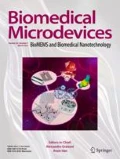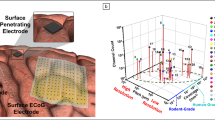Abstract
The success achieved with implantable neural interfaces has motivated the development of novel architectures of electrode arrays and the improvement of device performance. The Utah electrode array (UEA) is one example of such a device. The unique architecture of the UEA enables single-unit recording with high spatial and temporal resolution. Although the UEA has been commercialized and been used extensively in neuroscience and clinical research, the current processes used to fabricate UEA’s impose limitations in the tolerances of the electrode array geometry. Further, existing fabrication costs have led to the need to develop less costly but higher precision batch fabrication processes. This paper presents a wafer-scale fabrication method for the UEA that enables both lower costs and faster production. More importantly, the wafer-scale fabrication significantly improves the quality and tolerances of the electrode array and allow better controllability in the electrode geometry. A comparison between the geometrical and electrical characteristics of the wafer-scale and conventional array-scale processed UEA’s is presented.












Similar content being viewed by others
References
D.J. Anderson, K. Najafi, S.J. Tanghe, D.A. Evans, K.L. Levy, J.F. Hetke, X.L. Xue, J.J. Zappia, K.D. Wise, Batch-fabricated thin-film electrodes for stimulation of the central auditory system. IEEE Trans Biomed Eng 36, 693–704 (1989)
R. Bhandari, S. Negi, L. Rieth, F. Solzbacher, “A Wafer Scale Etching Technique for High Aspect Ratio Implantable MEMS Structures,” accepted in Sensors and Actuators Phys (2010)
Q. Bai, K.D. Wise, D.J. Anderson, A high-yield microassembly structure for three-dimensional microelectrode arrays. IEEE Trans Biomed Eng 47, 281–289 (2000)
R.B. Beard, B.N. Hung, R. Schmukler, Biocompatibility considerations at stimulating electrode interface. Ann. Biomed.Eng 20, 395–410 (1992)
R. Bhandari, S. Negi, L. Rieth, R.A. Normann, F. Solzbacher, A novel method of fabricating convoluted shaped electrode arrays for neural and retinal prosthesis. Sensors and Actuators Phys 145-146(1-2), 123–130 (2008)
R. Bhandari, S. Negi, L. Rieth, R.A Normann, F. Solzbacher, A novel masking technique for high aspect ratio penetrating microelectrode arrays. Journal of Micromechanics and Microengineering, doi:10.1088/0960-1317/19/3/035004, 2009.
R. Bhandari, S. Negi, L. Rieth, F. Solzbacher. Wafer-scale processed, low impedance, neural arrays with varying length microelectrodes. in Proceedings of Transducers ’09, Denver, USA, June 21–25, 2009.
A. Branner, R.B. Stein, R.A. Normann, Selective stimulation of cat sciatic nerve using an array of varying-length microelectrodes. J Neurophysiol 85, 1585–94 (2001)
P.K. Campbell, K.E. Jones, R.J. Huber, K.W. Horch, R.A. Normann, A silicon-based, three-dimensional neural interface: manufacturing processes for an intracortical electrode array. IEEE Trans Biomed. Eng. 38, 758–768 (1991)
T.K. Chowdhury, Fabrication of extremely fine glass micropipette electrodes. J Phys E Sci Instrum 2, 1087–1090 (1969)
K.L. Drake, K.D. Wise, J. Farraye, D.J. Anderson, S.L. BeMent, Performance of planar multisite microprobes in recording extracellular single-unit intracortical activity. IEEE Trans. Biomed. Eng. 35, 719 (1988)
D.J. Edell, V. Toi, V.M. McNeil, D. Clark, Factors influencing the biocompatibility of insertable silicon microshafts in cerebral cortex. IEEE Trans.Biomed .Eng 39, 635–643 (1992)
T.A. Fofonoff, S.M. Martel, N.G. Hatsopoulos, J.P. Donoghue, I.W. Hunter, Microelectrode array fabrication by electrical discharge machining and chemical etching. IEEE Trans. Biomed. Eng. 6, 890–895 (2004)
S. Gagne, R. Plamondon, Open tip glass microelectrodes: conduction through the wall at the tip. IEEE Trans Biomed Eng 4, 56–61 (1987)
J.-M. Hsu, S. Kammer, E. Jung, L. Rieth, R.A. Normann, F. Solzbacher, Characterization of parylene-C film as an encapsulation material for neural interface devices (Borovets, Bulgaria, 2007). presented at 4M2007 Conference on Multi-Material Micro Manufacture
J.-M. Hsu, L. Rieth, R.A. Normann, P. Tathireddy, F. Solzbacher, Encapsulation of an integrated neural interface device with parylene-C. IEEE Trans. Biomed. Eng. 55, 1–7 (2008)
K. Jones, P. Campbell, R. Normann, A glass/silicon composite intracortical electrode array. Ann Biomed Eng 20, 423–437 (1992)
S. Kim, R. Bhandari, M. Klein, S. Negi, L. Rieth, P. Tathireddy, M. Toepper, H. Oppermann, F. Solzbacher, Integrated Wireless Neural Interface Based on the Utah Electrode Array. Biomedical Microdevices, doi: 10.1007/s10544-008-9251-y, (2008)
D. Kipke, R. Vetter, J. Williams, J. Hetke, Silicon-substrate intracortical microelectrode arrays for long-term recording of neuronal spike activity in cerebral cortex. IEEE Trans Neural Syst Rehabil Eng 11, 151–155 (2003)
A. Manduca, T.E. Oliphant, M.A. Dresner, J.L. Mahowald, S.A. Kruse, E. Amromin, J.P. Felmlee, J.F. Greenleaf, R.L. Ehman, Magnetic resonance elastography: non-invasive mapping of Ttissue elasticity. Med Image Anal 5, 237–254 (2001)
M. Mojarradi, D. Binkley, B. Blalock, R. Andersen, N. Ulshoefer, T. Johnson, D.C. Linda, A miniaturized neuroprosthesis suitable for implantation into the brain. IEEE Trans Neural Syst Rehabil Eng 11, 38–42 (2003)
S. Musallam, M.J. Bak, P.R. Troyk, R.A. Andersen, A floating metal microelectrode array for chronic implantation. J Neurosci 160, 122–127 (2007)
S. Negi, R. Bhandari, L. Rieth, and F. Solzbacher. Effect of sputtering pressure on pulsed-DC sputtered iridium oxide films for neuroprosthetic applications. Sensors & Actuators B Chem, doi:10.1016/j.snb.2008.11.015, (2008)
D.A. Robinson, The electrical properties of metal microelectrodes. Proceedings of the IEEE 56, 1065–1071 (1968)
P.J. Rousche, R.A. Normann, A method for pneumatically inserting an array of penetrating electrodes into cortical tissue. Ann Biomed Eng 20, 413–22 (1992)
O.F. Schanne, M. Lavallee, R. Laprade, S. Gagne, Electrical properties of glass microelectrodes. Proceedings of the IEEE 56, 1072–1082 (1968)
Acknowledgement
This work was supported in part by NIH/NINDS Contract HHSN265200423621C and by DARPA under Contract N66001-06-C-8005.
Author information
Authors and Affiliations
Corresponding author
Rights and permissions
About this article
Cite this article
Bhandari, R., Negi, S. & Solzbacher, F. Wafer-scale fabrication of penetrating neural microelectrode arrays. Biomed Microdevices 12, 797–807 (2010). https://doi.org/10.1007/s10544-010-9434-1
Published:
Issue Date:
DOI: https://doi.org/10.1007/s10544-010-9434-1




